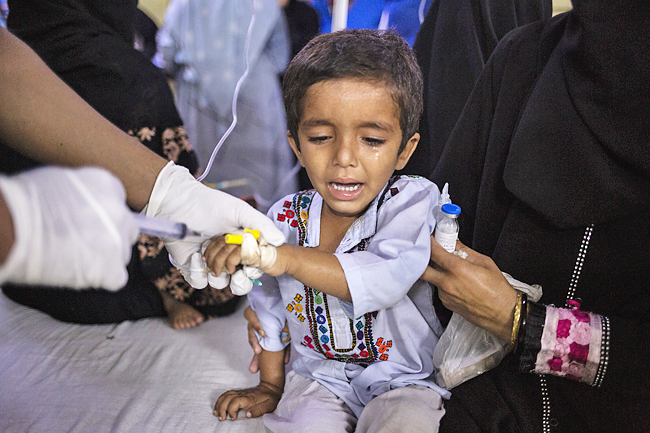THE WASHINGTON POST – Muhammad Yaqoob stood on his concrete porch and watched the black, angry water swirl around the acacia trees and rush toward his village last September, the deluge making a sound that was like nothing he had ever heard. “It was like thousands of snakes sighing all at once,” he recalled.
At first, he thought villagers’ impromptu sandbags, made from rice and fertiliser sacks, had helped save their homes and escape Pakistan’s worst floods on record.
But Yaqoob – whom villagers call a wadero, or chief – soon realised it was just the beginning of a health disaster. The temperatures rose to triple digits, as the water that would not recede festered in the sun.
An elderly woman died in a boat on the way to the hospital, overcome by heat and dehydration. Dark clouds of mosquitoes bit through even the toughest donkey’s hide, spreading malaria to Yaqoob and four dozen of his neighbours.
People came down with itchy dermatitis from walking through the floodwaters.
Farmers who could not plant in drenched fields began cutting back their simple meals of vegetables and rice from three a day to two. And then, for some, just one.
“I had no idea what miseries this flood would bring for us,” said Yaqoob, whose village is in Sindh, the hardest hit province in a disaster that left a third of the country underwater.



Pakistan is the epicentre of a new global wave of disease and death linked to climate change, according to a Washington Post analysis of climate data, leading scientific studies, interviews with experts and reporting from some of the places bearing the brunt of Earth’s heating. This examination of climate-fuelled illnesses – tied to hotter temperatures, and swifter passage of pathogens and toxins – shows how countries across the globe are ill-prepared for the insidious, intensifying risks to almost every facet of human health.
To document one of the most widespread threats – extreme heat – The Post and CarbonPlan, a nonprofit that develops publicly available climate data, used new models and massive data sets to produce the most up-to-date predictions of how often people in nearly 15,500 cities would face such intense heat that they could quickly become ill – in the near-term and over the coming decades.
The analysis is based on a measure called wet-bulb globe temperature (WBGT), which takes into account air temperature, humidity, radiation and wind speed, and is increasingly used by scientists to determine how heat stresses the human body.
Pakistan experiences some of the most intense heat on the planet. Cities such as Jacobabad and Hyderabad are projected to have several months each year when conditions are so extreme that even people in the shade face health risks.
Other regions projected to face increasingly severe heat waves include the Middle East, India and parts of Vietnam and China.
When taking into account the force of the sun, the health risks are even higher. Over 40 million people in Pakistan would endure dangerous heat for more than half of the year unless they can find shade.
In the United States (US), more dangerous heat will envelop large parts of the South and Southwest.
The Post analysis showed that by 2030, 500 million people around the world, particularly in places such as South Asia and the Middle East, would be exposed to such extreme heat for at least a month – even if they can get out of the sun.
The largest population – 270 million – was in India, followed by nearly 190 million in Pakistan, 34 million across the Arabian Peninsula and more than one million apiece in Mexico and Sudan.
The results show how the risk has been growing and will escalate into the future. The number of people exposed to a month of highly dangerous heat, even in the shade, will be four times higher in 2030 than at the turn of the millennium.
By 2050, the number of people suffering from a month of inescapable heat could further grow to a staggering 1.3 billion. At this point, vast swaths of the Indian subcontinent will swelter under extreme humid heat, as will parts of Bangladesh and Vietnam. Only those who can find cooling will find respite.
To reach these estimates, The Post and CarbonPlan combined one of the most detailed sets of historic heat data with the latest climate projections produced by NASA supercomputers, offering one of the most detailed estimates of current and future heat stress at a local level ever produced. The projections assume countries make steady progress toward cutting planet-warming emissions, as they have committed to do.
The Post defined its dangerous heat threshold as more than 89.6 degrees Fahrenheit wet-bulb globe temperature, equal to a temperature of 120 degrees on a dry day, or mid-90s temperature on a very humid day.
Spending more than 15 or so minutes beyond that limit, many researchers said, exacts a harsh toll on even a healthy adult; many deaths have occurred at much lower levels.
Extreme heat, which causes heat stroke and damages the heart and kidneys, is just one of the ways that climate change threatens to cause illness or kill.
So far this year, more than 235,000 Peruvians have come down with dengue fever and at least 399 died, according to Peru’s national center for disease control, the most in that nation’s history. Smoke from record-breaking Canadian wildfires billowed across the US, triggering asthma attacks that forced hundreds to seek hospital care. And East Africa’s worst drought in at least 40 years, which has spurred widespread risk of famine, is 100 times more likely to have happened because of human-caused warming, researchers said.
The number of heat-related deaths of people over 65 increased by 68 per cent from 2017 and 2021 compared with between 2000 and 2004, according to a peer-reviewed report from the Lancet last year, while the months of favourable conditions for malaria in the Americas’ highlands rose by 31 per cent between 2012 and 2021 compared with 60 years earlier.
“We can say now that people are dying from climate change, and that’s a different kind of statement than we would have made before,” said professor Kristie L Ebi in the Centre for Health and the Global Environment at the University of Washington who co-authored the 2022 Lancet Countdown report. “Climate change is not a distant threat to health, it’s a current threat to health.”
Many of the most affected countries have contributed the least to the climate crisis, and are ill-prepared to manage the rapidly multiplying threats.
“I had no idea what miseries this flood would bring for us.”
Last year in Pakistan, dangers piled one atop the other. First, the country suffered a record-breaking heat wave beginning in March. Fires rampaged through its forests. Record high temperatures melted glaciers faster than normal, triggering flash floods. And then heavy monsoon rains caused unprecedented floods, which left 1,700 dead, swept away two million homes and destroyed 13 per cent of the country’s health-care system.
“Pakistan’s crisis was almost prophetic,” said Sherry Rehman, Pakistan’s outgoing climate minister, in a phone interview. “Look at this summer.”
As the world shatters temperature records – this year is now likely to be the warmest in recorded history – she said, “countries like us, the hot spots, are going to feel the burn immediately”.





